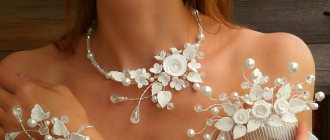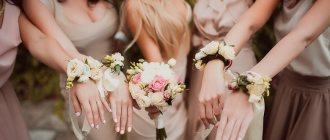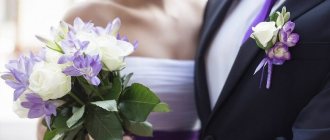To create a boutonniere from a satin ribbon with your own hands you will need:
- 13 pieces of white ribbon - 2.5*10 cm (7 pieces for sewing together and making the bottom layer of the composition, 6 for petal-cups);
- 27 pieces of white ribbon - 2.5*6 cm (to make three roses, 9 petals each);
- 3 pieces of narrow white tape - 0.5*10 cm;
- 4 pieces of white beads on a thread - 10 cm;
- 6 half beads in the form of white mother-of-pearl pearls - 6 mm in diameter;
- 2 white felt circles - 3 cm and 4 cm;
- base for attaching the decoration in the form of a 7.5 cm clip or a large pin.
These wedding decorations are a multi-layered snow-white composition consisting of three rose buds, a snowflake of bunched leaves and a lower white daisy. To create all the details and attach them into one bouquet, you need to prepare a ruler, scissors, a lighter, a glue gun, a needle with white thread and a soldering iron.
The meaning of jewelry for the bride
This accessory does not play a special role for the bride, because she has a wedding bouquet for this. But if a girl getting married decides to use a boutonniere, then it is better to abandon the bouquet. After all, if the image of the newlyweds contains both elements, then it will look very vulgar.
Photo boutonniere for the bride.
As a rule, a boutonniere for a bride is quite large. Therefore, the bouquet can easily merge with this decoration. This accessory allows you to free up the hands of a girl getting married.
This allows the fair sex to feel more confident and not think about where to put the bouquet at one time or another.
Some people wonder whether the bride needs such decoration. There is no definite answer here, because this accessory is more masculine than feminine. Therefore, the newlywed must answer this question for herself. If you want to give preference to such decoration, then why not.
It is also worth considering that if the bride wants to wear a boutonniere, it should be harmoniously combined with the bridesmaid’s decoration. After all, the newlywed and girlfriend will be constantly together on this day. And everyone should see and understand who is who.
Of course, these accessories do not have to be the same, but they should be designed in approximately the same style.
Such different boutonnieres
Many people are concerned about whether the witness needs such an element at the wedding.
It is impossible to answer this question unequivocally. Here a lot depends on the personal preferences of the bride and groom. You need to rely only on their taste, because this is their celebration. However, a boutonniere for a witness at a wedding will be a great addition, as well as a wonderful addition to the groom's look. If you decide that your witness needs this element, select it yourself and hand it over a day or several days before the wedding.
This is ideal. Such a gesture will indicate that you trust your friend to have an honorable role at the wedding .
It’s better to do just this, because in this case you will be able to choose the right pair for the groom’s decoration. Important!
The boutonnieres of the groom's witness should be different. The second should be smaller and more modest, repeating only the main style of decoration of the groom.
How to make it yourself
A hand-made bridal bouquet made from artificial flowers looks very stylish. To create a floral arrangement, you should think about what it should highlight. You will also need a little patience, imagination and positive emotions. You can use all available materials - paper, fabric, decorations, ribbons.
https://youtube.com/watch?v=AhSrVa8KWxA
From fabric
Wedding bouquets from artificial buds are created in stages. The choice of fabrics for artificial flowers today is quite wide. You can also use ready-made fabric buds as a basis. All leaves are carefully trimmed from them. The largest element is placed in the center, and smaller ones are attached to the sides. The stems are fixed with floral wire or tape along the entire length. You need to start from the top, gradually moving down. The leg should be tight. We secure the end of the tape using a regular button.
We decorate the stems with openwork lace or satin ribbons.
We give the finished bouquet the required shape of a ball or hemisphere. An accessory made from fabric will please the eye for a very long period of time.
From paper
To make a paper flower, you need to prepare petals of different sizes. We make five different templates, cut out 4 identical petals.
We twist the leaves onto a pencil, giving them shape. We attach one petal to the wire using glue. This will be the center of the flower. Next, we glue the rest to it one by one. You need to start with the smallest ones. You need to use connected petals so that one slightly overlaps the other. A tape is glued to the base, which is used to wrap the stem. We form the flowers into a composition of the desired shape and decorate.
From tapes
For the base, take a circle with a diameter of 5-10 cm from burlap, the entire flower will be attached to it. Cut a hole in the center. We connect the ends of the circle to form a cone.
Smoothly apply ribbons to the base. We secure the ends with regular thread. It turns out to be a rose. If you work with a satin ribbon, the color will be more saturated.
To get the stem or stem of a bouquet, you need a stick of the appropriate length. We decorate the future leg with ribbon, and glue a paper ball on top of it. We attach roses to this ball.
From beads
We will need 6 identical beads and one slightly larger for the flower. Beads are strung on a thread or soft wire. You can alternate them with beads. Twist the thread into a ring and tie a knot. Using glue, attach a large bead to the center.
We prepare a leg from wire to which we attach flowers. We carefully decorate the wire with ribbons, lace or a bow. If you choose original material, the composition will look stylish and creative.
Main materials of manufacture
The groom's boutonniere is made from the following materials:
- Made from fresh flowers - such an accessory looks natural and natural, but loses its original freshness long before the end of the wedding. Therefore, when choosing this option, florists recommend stocking up on a second copy, which can be worn if the first one fades.
- Artificial flowers are a more practical option, which is preferred at weddings in the cold season. Such decoration will not stain the suit, will not turn black, and will delight the eye with its fresh appearance throughout the entire celebration.
- Made from foamiran - a soft material used to create various flower arrangements. These boutonnieres look quite natural, gentle, and elegant.
- From multi-colored ribbons - using the kanzashi technique, you can make a variety of floral accessories from ribbons. Satin roses, chrysanthemums, daisies, peonies will become a bright detail on the groom's suit. You just need to choose a good color combination, not to overdo it with the brightness of colors or originality of shapes.
- From organza and mesh - from floral material, light original boutonnieres are obtained, which are additionally decorated with a special mesh along the edges. If desired, the mesh is decorated with berries, rhinestones, beads or feathers.
- Silk is a delicate, thin material that successfully imitates the shape of buds, leaves, and flower inflorescences.
- From polymer clay, you can make such a boutonniere yourself, since it does not need to be baked. It is enough to give the polymer clay the desired shape, and it will harden itself within a day. Wire pre-wrapped in green tape is used as stems for clay buds.
To keep a bouquet of fresh flowers fresh for a long time, you first need to cut each flower stem obliquely and then dip it in wax.
Natural flowers
Ribbons
Artificial flowers
Polymer clay
Foamiran
How to make a boutonniere from satin ribbons for the groom
Making a boutonniere with your own hands using ribbons for the groom is not too long or troublesome. When you have decided on the main composition, you should collect all the decorations that will serve as an addition. Walk around your apartment and you will definitely find something interesting: rhinestones, buttons, beads, bows, wire, mesh, ribbons. If the stem of a living flower is inserted into the composition, it is better to play it safe and purchase several. After all, plants are very fragile and can be easily damaged.
You should not overload the accessory with details such as bows and beads, since the line between elegance and absurdity is very easy to step over. Don’t be afraid to use your imagination, because this approach will allow you to create a stylish, beautiful and unique decoration. The main thing is that there is no rush, then the result will please you. If you have a desire to make a boutonniere with your own hands using ribbons, we are ready to share a master class with you.
Necessary materials
To create you will need the following:
matching threads, needle; satin ribbons of one, two, or three colors, the width of which is 2.5 cm; scissors; candle; decorative pin; button; ruler.
Stages of creation
We cut the ribbons into the following sections: 6 by 8.5 cm, 7 sections by 11 cm, 5 by 6 cm.
We seal the edges with fire so that they do not crumble. We carefully pass the burning candle over the braid.
We bend the 11 cm tape in the middle to form a right angle. We bend the edge that is directed to the right back, comparing it with the base. The first petal is ready.
We do this with the remaining six pieces of ribbon. We collect the flower with threads and secure it tightly with a knot.
We will do the same with ribbons of 8.5 and 6 cm. Three flowers of different sizes are ready.
It is necessary to connect the flower by threading a thread through the center of the largest, medium and small.
Sew on a button. From the reverse side, a decorative pin is threaded through the boutonniere and attached to the jacket.
How to attach a boutonniere to a jacket
In order for the wedding celebration to go perfectly, it is important not to forget to take into account every little detail. Such significant details include the boutonniere, which is attached to the groom's suit.
It would seem that it could be simpler, but even in such a simple matter, mistakes can be made.
We attach the boutonniere to the groom's jacket
If you want to have a wedding according to all the canons, then it is worth including such a touching tradition as attaching a boutonniere. This is done by the bride after the groom gives her a wedding bouquet. Initially, she took out a couple of flowers from it, immediately made a boutonniere out of them and inserted it into her buttonhole. But since this takes a lot of time, and not all brides can do it as beautifully as floral designers, this element of tradition is omitted in most cases.
This action is not always carried out at the wedding itself. Many newlyweds do not see the point in this tradition, so the boutonniere is attached in advance, while preparing the costume.
She can look whatever she wants. The classic version was described above - these are flowers from the bride’s bouquet. But it could be another bouquet that has something in common with it in color (although this is not necessary). Additional decorations are also used: feathers, spikelets, grass and leaves. There are also completely non-standard options, for example, with small figures, bells, cones or pearls.
Where to attach
Traditionally, this is the left lapel of the jacket, closer to the heart. But modern newlyweds like to deviate from standard wedding looks, so more and more often you can see grooms wearing a shirt, or at most, a vest over it. In both cases, the boutonniere is attached to the breast pocket.
IMPORTANT! This will be discussed below, but it should be attached to the pocket, and not inserted into it. Many of those who organize a wedding in the same style like to add additional unifying elements to the guests’ costumes.
One option could be identical bouquets that decorate witnesses and/or parents of the bride and groom
Many of those who organize a wedding in the same style like to add additional unifying elements to the guests’ costumes. One option could be identical bouquets that decorate the witnesses and/or parents of the bride and groom.
For men, the requirements remain the same (except that their boutonniere should not be more striking than that of the groom). Women attach a bouquet near the neckline of a dress or on a belt. Bracelets with boutonnieres are also common.
How to attach
A ready-made purchased (or ordered) bouquet is most often initially attached to a clip or safety pin. But there are exceptions, in which case two corsage pins will help you. To attach the boutonniere:
- pierce the lapel of the jacket from the inside;
- pass the pin through the stem, closer to the flower;
- bring it back into the fabric;
- attach the second pin in the same way, passing it through the bottom of the stem.
The same sequence of actions is suitable for hand-made boutonnieres.
BY THE WAY! If you do not want to follow tradition and prepare this element of the costume in advance, then for reliability you can sew it with threads, and then you can certainly be sure that it will not fall off at the most inopportune moment.
Basic mistakes
There are two of them. The first is that many people do not care about securing the boutonniere and simply “put” it in their breast pocket. This is very unreliable, since the bouquet can fall out from any movement, even if the groom simply raises one hand up, not to mention dancing and active competitions.
Secondly, many people consider flowers to be the most important element of a boutonniere, so the stems are either cut off or hidden. As a result, the resulting decoration looks incomplete and unfinished. The leg adds elegance and naturalness to it.
To follow or not to follow traditions is up to you to decide. But in any case, the boutonniere will become an exquisite detail of the groom’s image, which means it is in your best interests to make sure that it is held as securely as possible.
How to attach
Boutonnieres are often glued to all kinds of clips and safety pins. There are also special pins called "gala clips". They allow you to fasten the decoration to the fabric without much difficulty. But if there is no reliable clamp, then you can use two corsage pins:
- pierce the lapel with a pin from the wrong side;
- pierce the boutonniere through;
- insert the pin back into the fabric;
- Carry out the same manipulations with the second pin.
As a result, your bouquet will be securely fastened. If you are afraid that the boutonniere will come off during dancing, then you can sew it to the costume in advance, but in this case you will not be able to follow the tradition.
If you are making a boutonniere for the groom with your own hands, then choose only fresh flowers with a dense base and elastic petals. They should echo the flowers from the bride’s wedding bouquet. Use wire to make the miniature composition rigid and hold its shape well. Wrap the flower stems with ribbon or twine. In this case, they will not stain the suit fabric, and they will look better.
Try to make the decoration so that it stands out on the suit, is bright, but not provocative. In addition to fresh flowers, you can use other non-standard items - feathers, spikelets, herbs, leaves. Designers make miniature guitars, fairy-tale characters, watches, and attach bells, pine cones and pearls. When it comes to making wedding decorations, imagination knows no bounds.
Comments (0)
Classic wedding boutonniere made of fresh flowers
To make a boutonniere from fresh flowers, you must first decide on the choice of inflorescences. The ideal option is an unblown rose, as it has a neutral scent and retains its original appearance for a long time in a warm room.
Purchase the following from your florist in advance:
- fresh roses (color of your choice);
- ornamental plants with small inflorescences (rosemary, gypsophila, lavender);
- various pins with large pearls at the end (3-4 pieces);
- sharp pruning shears;
- specialized floral tape;
- floral wire;
- satin ribbon (10-20 cm);
- tape;
- cotton pad (1-2 pcs.);
- solution for flowers “Vitant” or “Chrysal”;
- a pin for attaching the boutonniere to the fabric;
- wire cutters.
Before making the boutonniere, check that you have all the necessary parts, since you will be working with fresh flowers, which have the ability to quickly lose their fresh appearance.
Place the roses in water with the addition of Chrysal solution for 4-6 hours so that they are saturated with a special substance that helps retain moisture in the bud.
Next, do everything step by step:
- Cut the stem of the rose with pruning shears so that there is a distance of about 4-6 cm from the bud. Immediately after this, wrap the cut with a small piece of cotton pad soaked in the Chrysal solution and secure with tape.
- Take a wire (5-8 cm) and carefully thread it at the base of the rose stem, bend it in half to get pieces of equal length. Connect them and twist them together. This is the basis of the future boutonniere. Cut off the remaining wire with wire cutters.
- Start wrapping the resulting stem with green tape.
The procedure requires special care, since the most important thing is to carefully wrap the wire without catching the living petals at the base of the bud. If you did everything correctly, then you will have a smooth transition from a living bud to an artificial stem. - Attach decorative elements to the sides of the rose and secure with floral tape. If desired, you can additionally add pins with pearls.
- The final touch is thin satin ribbons that will complete your floral arrangement.
After making the boutonniere, it should be attached to a pin with wire, placed in a sealed bag and placed in a cool place until ready to use.
Boutonniere options
This accessory can be made from a wide variety of materials:
- Natural flowers;
- artificial plants;
- paper;
- textile;
- tape and much more.
Based on this, you can choose the boutonniere option. After all, you must admit that not every girl loves fresh flowers. Some people are allergic to them. This is precisely why there are alternative options.
Artificial plants
This is a material that allows you to create absolutely any composition. Today in stores you can find many ready-made options, and for handicrafts there are a bunch of ready-made blanks that allow you to create beautiful bouquets.
You can secure the finished composition with a satin ribbon or elastic band. Such a product can be stored for quite a long time. Therefore, if the bride’s bouquet is given to the guests, the boutonniere will remain for many years.
Natural flowers
These plants are quite capricious and although it is not difficult to create a beautiful composition with them, preserving them will be problematic. Experienced florists use special granules that allow flowers to receive moisture throughout the day.
This accessory is made from natural flowers if the bride does not additionally use a bouquet.
To create such masterpieces they often use:
- orchids;
- roses;
- peonies;
- other flowers.
It is best to choose plants that are more drought tolerant. It’s not a fact that granules will be able to maintain flowers in their original state all day long. Each plant consumes water differently and this should be taken into account when choosing species.
From fabric
Fabric boutonnieres also turn out very beautiful and attractive. They look especially good on brides. In many cases, the production of such an accessory is entrusted to a professional, because not every representative of the fair sex has the gift of sewing.
You can complement such decoration with decor in the form of buttons, beads, ribbons and much more. In any case, if you give your preference to fabric boutonnieres, you will not be dissatisfied.
From paper
Boutonnieres are rarely made from such material, because paper tends to deteriorate quickly. Also, if water gets on it, it will lose its attractiveness. But there are some brides who are not averse to experimenting.
If you are one of these representatives of the fair sex, then it is worth knowing some of the subtleties of creating a paper boutonniere.
It is also recommended to practice a few weeks before the wedding. If you succeed, then you can create the final version of the accessory.
DIY boutonniere
Boutonniere (“boutonniere” from French) translates as “flower in the buttonhole.” During the revolution in France, a red carnation on the costumes of nobles condemned to execution meant their courage and fearlessness. Later, the working class began to wear flowers at rallies and demonstrations. Over hundreds of years, the accessory has not changed much in appearance, but its meaning has changed. Nowadays the boutonniere is used as an accessory for suits and dresses.
From a living rose
To create an accessory for the groom, take a fresh rose (preferably white), cut the stem at an angle, leaving the length you need (at least 10 mm), then put the plant in water for two to three hours. After that, follow the step-by-step instructions:
Recent posts 15 minutes and you're done: 3 original knife standsFrom a cardigan to a pillow cover: 8 ideas for repurposing an old sweaterWater and vinegar: an easy way to remove unpleasant odors from clay dishes
- Treat the edge of the flower with floral glue. Moisten a small piece of cotton wool a little with water, attach it to the stem and secure with a green ribbon.
- Take the wire and divide it into two parts. The wire must be passed through the stem of the flower crosswise.
- Bend the wire along the stem. Take another wire, divide it into four equal parts, bend the tip of one into a hook shape.
- Place the greens on the hook and secure the product with tape.
Boutonniere bracelets for bridesmaids
A boutonniere is a decoration not only for the groom’s suit. You can make beautiful boutonniere bracelets for bridesmaids in the same style as the bride’s bouquet.
- Take a compass or pencil, draw a circle on the cardboard, then cut it out with scissors.
- Take four types of material - silk, tulle, chiffon and cotton fabric. Alternatively, you can take another dense material. Place the cut out template on the fabric, cut out 10 circles, then fold them in half twice.
- Closer to the corner, secure the petal with several stitches, for this use a thread of the appropriate color.
- Form the flower by gluing the petals to the template so that their edges intersect. Alternate different types of fabric.
- Attach the fabric rose to a satin ribbon using glue. The finished accessory can be decorated with rhinestones or beads.
Satin ribbon flower for guests
A boutonniere for guests, which can be attached to an outfit, is made according to a similar principle. In this case, instead of a flower, you can use lavender flowers, beautiful feathers, leaves, ribbons and even forest cones - the main thing is that in color and style they match the wedding dresses of the future newlyweds.
Master class on creating decorations from satin ribbons for guests:
- Cut the ribbons into several pieces of different lengths. You can use the following values: six segments of 8 centimeters, seven of 11 and five of 6.
- Pass a burning candle over the braid to secure the edges of the ribbons. Fold the longest ribbon in the middle until a right angle is formed, then fold the edge directed to the right - you should get a petal.
- Thread the base of the leaf with small stitches, then release it to the knotted end of the thread. Do the same with other 11 centimeter ribbons. Secure the flower tightly with a knot.
- Do the same with all the remaining pieces of satin. You will get three flowers of different sizes. Connect them with a thread, threading it through the centers of the flowers.
- Sew on a button. From the inside, pass a pin through the blank; with its help, the boutonniere will be attached to the outfit.
A boutonniere is a versatile wedding accessory that can be used in the outfits of the groom, bridesmaids and party guests. Use fresh flowers and ribbons to create them, complement them with decorative elements.
Attach a boutonniere to a jacket: step-by-step instructions
If you bought this decoration in a wedding accessories store, it should have a special mount. If you don’t have one, or you made this decoration yourself, you can use large pins, safety pins or various clips. It is better to glue the fastening element closer to the flower heads with double-sided tape.
Advice! It is better to buy a boutonniere in a specialized wedding jewelry store.
To secure the accessory to the jacket, you need to insert a pin into the buttonhole on the lapel of the jacket and securely fasten it.
If the clip is not attached to the accessory, you can attach the boutonniere as follows:
- Take a regular pin and pierce the lapel on the back side.
- Next, pierce (preferably through) the flowers in a softer place.
- Pierce the jewelry again and return the needle to the wrong side.
- Secure the pin and straighten the bouquet.
Now let’s take a closer look at the position of this part of the groom’s image.
Where the boutonniere is attached to the jacket: visual examples in the photo
According to tradition, the location of this decoration is the lapel of the jacket. A wedding jacket usually has a special buttonhole for attaching this element. However, many modern models do not have it, so flowers have to be attached without a buttonhole.
Regardless of whether a special buttonhole is provided or not, the boutonniere is attached to the lapel of the jacket.
When preparing the groom's outfit, you need to take into account some nuances. One of these is the question: what to do if the suit does not include a jacket?
In this case, you need to proceed as follows:
If the groom is wearing a vest, you need to attach the decoration to the left side, stepping back some distance from the neckline.
If the groom is wearing a shirt - to the pocket or slightly above it.
Interesting idea!
If the groom's suit has decorative suspenders, the boutonniere can be attached to the left strap.
How a boutonniere is attached to a jacket, depending on the material of manufacture
Traditionally, this element is made from natural flowers.
An excursion into history!
According to a long-standing tradition, a boutonniere was part of the bride's bouquet. After the groom handed the bouquet to the bride, she took out one flower, cut it, and attached it to her lover’s jacket.
The modern world is moving away from traditions, and at the moment this accessory is not only made in advance, but can also be made from various materials, even artificial ones. The material of manufacture, in turn, affects the method of fastening.
It is worth paying attention to the weight of the decoration. If it is made of beads or has a lot of stones or similar decorative elements, secure it with two or even three pins
In this case, the first one must be placed close to the head of the flower, the second one must be secured to the bottom of the stem.
Where to attach the groom's boutonniere?
Despite the fact that a boutonniere is an indispensable attribute of the groom’s outfit, not every young man knows how to wear this wedding accessory correctly. As a result, the boutonniere is put in a pocket, caught on the lapel of a jacket, or simply attached in such a way that by the middle of the wedding ceremony it simply falls off. To understand how, and most importantly where, to attach the boutonniere correctly, you need to turn to the history of this wedding attribute, because it, like the wedding garter, has its own history. There are many different legends about how the wedding boutonniere appeared.
One of them tells that in ancient times, during sports competitions and tournaments, the Egyptians attached flowers to the clothes of their favorite participants in these entertainments. Some legends indicate that this wedding accessory appeared because of another wedding attribute - the bride's bouquet. This is due to the fact that previously, during the wedding ceremony, the bride took out one flower from her wedding bouquet and attached it to the groom’s outfit, thereby showing him her love and respect. Now the tradition has changed a little and now the groom’s boutonniere is a separate wedding attribute, which is made based on the wishes of the young man himself and the theme of the wedding celebration. At the same time, the groom does not wear this accessory at the beginning of the wedding ceremony; the boutonniere is given to the groom by the bride after he gives her the wedding bouquet. In this case, it is the bride who must personally attach the boutonniere to the suit of her chosen one.
So where should the boutonniere be attached? If we translate the meaning of the word “boutonniere” literally, it turns out that this wedding accessory means a flower in a buttonhole. That is why it must be attached to the left lapel of the jacket, threading the accessory through the buttonhole. That is why it is worth ordering a boutonniere with a special fastening for the groom’s suit. If there is no buttonhole in the jacket, then the bride should attach the boutonniere to a regular pin, and it is worth paying attention to the fact that if the groom’s boutonniere is large, elongated and quite heavy, then it is best to use two pins at once to attach this accessory.
Features of wedding accessories
A girl’s chic festive dress and a young man’s formal suit are not all that is needed to create ideal images. Integral accessories are the bride's bouquet and the groom's boutonniere. Young people often have the opportunity to order them as a set. Such a bouquet and boutonniere are made in the same style. To create them, identical flowers, beads or ribbons are used. The unity of color and shape suggests that the lovers have something in common.
Since decorations made from fresh flowers are most often chosen for a wedding, the bouquet and boutonniere are made using them. Groomsmen and bridesmaids can also use similar details in their outfits.
The boutonnieres of the witnesses are slightly smaller than those of the groom, but they are created in the same style. For girls, in addition to dresses of the same color, bracelets are offered in the same design as the bride's bouquet. A single style is maintained both for decorative floral inserts in the bride’s hairstyle and for table decoration.
The same ribbons (usually satin) are often used for the bouquet and boutonniere. They wrap the base of the bouquet. However, no less stylish would be the option of wrapping flowers with burlap rope or twine.
Following tradition, the groom gives the bouquet after the “ransom”. Meanwhile, the bride attaches a boutonniere to her chosen one’s suit, thereby showing her love and tenderness. It turns out especially touching if the accessories are made by the hands of the couple themselves.
A flower in a buttonhole or the history of a boutonniere
The men's accessory, which today is most often used to decorate the groom's clothing, has gone through a difficult and thorny path. The history of the boutonniere contains many different pages - romantic, idle, funny and not so, sometimes even tragic, and undoubtedly deserves attention.
The name of the accessory comes from the French word Boutonnière and means “flower in the buttonhole.” As the name suggests, it is an ornament in the form of one or more flowers that is worn in the buttonhole of a jacket.
Historians are divided on the question of where this accessory was born. Some say that a small bouquet of aromatic herbs first began to be pinned on the groom’s clothes in Ancient Greece. It was attached to the left, in the area of the heart, and it served as a talisman - it protected the groom and his feelings from evil gods who could turn him away from his chosen one. According to others, the history of this men's accessory goes back even further - to the times of the ancient civilization of the Egyptians, who pinned the flower to their clothes as a sign of support for players in sports competitions. One way or another, it was a man’s jewelry, which indicates that the stronger half of humanity is no less romantic. Medieval knights, without taking off, wore such small bouquets of flowers on their chests as a sign of love and devotion to their lady of the heart. The bouquets were made from the beloved's favorite flowers.
But the nature of this accessory was not always peaceful. The boutonniere was also used as a military badge. In England, participants in the civil war, known in history as the War of the White and Scarlet Roses, pinned a brooch in the form of a flower of the appropriate color as a distinctive sign of their side. And the word “boutonniere” itself appeared during wartime. During the French Revolution, this accessory became a symbol of the fearlessness of the revolutionary nobles. Before ascending the scaffold, they inserted a “butonnière” - a red carnation - into their buttonhole. The boutonniere acquired a special, political meaning in the mid-19th century. Representatives of the labor movement wore a red carnation in their buttonholes; it was their obligatory attribute at political demonstrations.
Making decorations from satin ribbons
An accessory made from such material will never lose its appeal. A bouquet of ribbons will be an excellent decoration in winter, because you must admit that fresh flowers can simply wither in the cold.
Modern accessories are pinned to clothing or worn on the arm. Most often, such decoration can be found on the groom’s jacket. It is a mandatory attribute for a man who has decided to become the head of the family.
When making a boutonniere from ribbons, you should rely on the following rules:
You need to create a decoration design depending on the theme and importance of the celebration. Flowers made from ribbons should be harmoniously combined not only with each other, but also with the outfit. You should choose only high-quality materials. The decor should not be too large. The central flower should be made so that it is different from the rest, but this does not mean that it should be huge. If you suddenly decide to add fresh flowers to a bouquet of ribbons, then you should choose those that will not cause an allergic reaction. Witnesses are encouraged to wear matching jewelry.
By following these rules, you can create an incredible composition yourself. If you don’t have a sense of taste, then you can turn to an experienced florist for help. He will tell you which flowers and plants go best together.
How to position and secure
Having decided on the design of the floral accessory, you need to find out how the boutonniere is attached to the jacket. Traditionally, the composition is attached not only to the groom’s suit, but also to the clothes of witnesses and other guests at the wedding. At the same time, each participant in the wedding celebration has their own rules for wearing this accessory:
- First of all, you need to decide where to attach the boutonniere to the groom. He should place a floral accessory on the left lapel of his jacket. For reliability, the bouquet is fixed with a special pin, which is masked with ribbons, decorative mesh, and beads.
- Bridesmaids should also decorate their outfit with a miniature floral arrangement. They can attach it to their wrist, belt, hair band, purse or even neckline. For bridesmaids, there is a certain rule on which side to hang the boutonniere: unmarried ones fix it on the left, married ones on the right.
- Unmarried groomsmen can place a floral accessory directly on the shirt. As in the case of girls, the location of the bouquet depends on marital status. Unmarried people should attach the boutonniere to the jacket on the left side, and married people - on the right.
When choosing a boutonniere, you need to take into account many details: design, shape of the composition, materials. You can make this accessory yourself or entrust this task to professionals.
What to make a boutonniere from
You can make a wedding accessory from fresh flowers, such as roses. These luxurious beauties adorn not only women, but also look solemn on men. If the bride’s wedding bouquet is dominated by other flowers, for the groom you can choose the ones that are most similar to your beloved’s bouquet.
It is better to order the boutonniere in two identical versions, in case one accessory fades, it can easily be replaced with a similar one. It’s a good idea to add a little greenery to fresh flowers in a boutonniere to refresh the look, but the main thing is not to overdo it!
The original boutonniere will be made from satin ribbons. It is perfect for a winter wedding, when fresh flowers may not withstand frost. In addition, such a boutonniere will not lose its original appearance throughout the entire wedding celebration and can be kept for a long time as a memory of the wedding.
If the bride has beading skills, you can make a boutonniere for the groom using beads. Such an accessory will look original and unusual on your lover’s wedding suit. In addition, beads are much cheaper than other materials and the time required to create a boutonniere will take much less.
You will get a beautiful boutonniere if you make it from foamiran. This is a fairly flexible and lightweight material, which can be purchased in specialized craft stores. Thanks to the different colors of this material, you can get any shade of boutonniere. In addition, foamiran is easy to paint and tint. It perfectly retains its original shape, looks natural and is easy to work with even for a novice artist. Ideas for foamiran boutonnieres are presented in the photo:
Boutonnieres can also be made from colored corrugated paper, artificial flowers, or fabric. It all depends on the creativity of the bride and on what style the wedding will look like.
Who attaches the boutonniere and how?
Who attaches the boutonniere to the groom? According to tradition, the bride pins the decoration to her beloved’s jacket. In this way, she symbolically shows that now she and the groom are one family. A boutonniere is a symbol of unity with the woman you love. When choosing a boutonniere, you should pay attention to the clasp. It must be comfortable and strong so as not to break or come undone at the most inopportune moment. If previously boutonnieres were attached to safety pins, now they are immediately made like brooches, which is much more convenient. But, in any case, when buying a boutonniere, you should immediately check the quality of the clasp, try to unfasten it, fasten it and pin it to avoid troubles.
Which side should I attach the boutonniere to? From the left. That is, closer to the heart, to feelings.
How many boutonnieres should the groom have? There should be at least two boutonnieres, especially if they are made from fresh flowers. During hugs, dances and competitions, the groom's boutonniere may simply become unusable.
After the celebration, the boutonniere is kept in the family. This stylish decoration is an important heirloom, as well as a memory of one of the most wonderful days in the life of the young couple.
What is a boutonniere
Modern boutonnieres are a small flower arrangement, the complexity of which depends on the skills of the florist and the individual wishes of the customer. It is considered good form if the same flowers are used for the boutonniere as for the bride’s bouquet. In addition to flowers, green twigs, ribbons, mesh, berries, beads, etc. are used. There are no restrictions as such - the composition can be made not from flowers, but from other natural materials, for example, shells. This directly depends on the style of the wedding itself.
The size of such an item is small - in total, the boutonniere should not be more than 10 cm in length.
A common misconception is that only the groom is entitled to a boutonniere. Perhaps at a time when flowers in a buttonhole at a wedding were not the most common and popular detail, this was the case. Nowadays, the groom’s boutonniere is as obligatory as the bride’s bouquet. In addition, the groom's friends and those guests who have a special status at the celebration can refresh their look with similar decoration. For example, fathers of the bride and groom, godparents, etc.
The groom attaches the composition to the left lapel of his suit, single men on the right, married men on the left. If not only the groom, but also some of the guests have a boutonniere, it is desirable that the flower on the groom’s lapel be different from the others. The difference may be in the size of the composition, the color of the color itself or the ribbon. However, at the same time, a unified style should be felt, there should be no fragmentation, otherwise it is better to completely abandon such decoration for guests.
When to attach the boutonniere
Immediately after the bride and groom put on their wedding dresses, the required attributes must be added to them: the bouquet is given to the bride, and a boutonniere is attached to the groom’s jacket. From the beginning of the celebration until the very end, they should be in sight: the bride should not let go of the bouquet or leave it somewhere away from her, and the boutonniere should be kept on her jacket.
The floral arrangement, which is supposed to be fixed on the lapel, is attached to the left side with a pin. The pin should be positioned with the eye down, and the “tails” of the ensemble should be hidden so that they do not create a sloppy effect.
Decorations made from fresh flowers, meant to be kept in a jacket pocket, often come with a water capsule, allowing them to stay fresh longer. In this case, also on the left side, the accessory is placed in a pocket and sometimes additionally secured with a clip.
General recommendations for making a bouquet
A handmade boutonniere will surprise and delight the groom. Before you start making, familiarize yourself with the basic “laws” that allow you to make a truly stylish accessory out of a product. Tips on how to make a boutonniere for the groom:
- The flower for the groom should fit into a single image (a white suit will complement a cream-colored product, and brighter colors are suitable for a black tailcoat);
- The color of the bouquet should be in harmony with the bride's bouquet.
- A boutonniere for a wedding can be made from live or artificial plants, as well as from satin ribbons.
- Contrasting colors of the product will look good in wedding photos.
- The size of the plant should not exceed 12 centimeters. A boutonniere that is too large will look bulky and disturb the groom.
- When making a bouquet from living plants, you should remember that it can wither during the day. Make a spare product so that it can be easily replaced if the main one fades.
How to make a bouquet of fresh flowers?
You can use both fresh and artificial flowers, satin ribbons
An accessory made from natural ingredients is not particularly durable, but it looks more stylish than one made from artificial materials. It must be made on the eve of the wedding. Materials you will need to make a boutonniere for the groom from fresh flowers:
- one large flower and several small ones (optional);
- greens or flowers;
- satin ribbon;
- glue for fresh flowers;
- tools (scissors or knife).
It is necessary to cut the flower at an angle, and be sure to treat the cut with glue so that the composition does not wither prematurely. Next, you need to add greenery, flowers and secure everything with wire, piercing the stem of the flower crosswise. Tie the resulting bouquet with a satin ribbon. This boutonniere made from fresh flowers should be secured with a pin. Don’t forget to take a photo of your handmade boutonniere as a souvenir.
Bouquet of ribbons
If you wish, you can find video tutorials on the Internet on how to make a boutonniere from satin ribbons. A handmade product made from satin ribbons will fit perfectly into any style of clothing of the couple. A huge range of colors of ribbons will give free rein to your imagination. A product of a similar type can be made by the girl herself, like a bracelet on her wrist. A bouquet of ribbons will not wither and can be kept as a keepsake for a long time, and then passed on to your children.
What is
A boutonniere is a single flower or a small floral arrangement attached to the buttonhole on a men's suit. A boutonniere is made from fresh flowers, artificial buds, leaves, decorative twigs, and berries. Its size is no longer than ten centimeters, including the peduncle.
The tradition of decorating men's clothing with flowers first appeared during Antiquity. But the word “boutonniere” itself came from France, where in the 17th-18th centuries this accessory became widespread as a symbol of wealth and high social status. Today it is a decorative element of a man’s image, intended for special occasions, but at the beginning of the 20th century not a single gentleman went out without it.
From French, “boutonniere” translates as “flower in the buttonhole.” This fashion accessory symbolized the beauty of nature, male fearlessness, and the fragility of human life.
The first wedding boutonnieres appeared in the 19th century after Prince Albert of England took a flower from his bride Victoria’s bouquet and inserted it into his buttonhole. Today, the boutonniere has become a mandatory attribute of the groom's suit.










